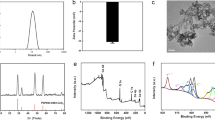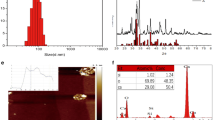Abstract
This study has investigated the effects of gold nanoparticles (Au NPs) on the proliferation, differentiation, and mineralization of a murine preosteoblast cell line MC3T3-E1 in vitro. The results show that Au NPs with diameters of both 20 and 40 nm promoted the proliferation, differentiation, and mineralization of MC3T3-E1 cells in a time- and dose-dependent manner at the concentrations of 1.5×10−5, 3.0×10−5, and 1.5×10−4 μmol/L. The reverse transcriptase polymerase chain reaction (RT-PCR) indicates that the expressions of runt-related transcription factor 2 (Runx2), bone morphogenetic protein 2 (BMP-2), alkaline phosphatase (ALP), and osteocalcin (OCN) genes increased after the 20 and 40 nm Au NP treatments, and the expression levels were higher than those of the NaF group. The above results suggest that Au NPs have the potential to promote the osteogenic differentiation and mineralization of MC3T3-E1 cells and the particle size plays a significant role in the process. Runx2, BMP-2, ALP, and OCN genes may interact with each other, further stimulating the osteogenic differentiation of MC3T3-E1 cells.
Similar content being viewed by others
References
Mazzola L. Commercializing nanotechnology. Nat Biotechnol, 2003, 21: 1137–1143
Paull R, Wolfe J, Hebert P, et al. Investing in nanotechnology. Nat Biotechnol, 2003, 21: 1144–1147
Marie-Christine D, Didier A. Gold nanoparticles: Assembly, supra-molecular chemistry, quantum-size-related properties, and applications toward biology, catalysis, and nanotechnology. Chem Rev, 2004, 104: 293–346
Frederix F, Friedt J M, Choi K H, et al. Biosensing based on light absorption of nanoscaled gold and silver particles. Anal Chem, 2003, 75: 6894–6900
Liu T, Tang J A, Zhao H Q, et al. Particle size effect of the DNA sensor amplified with gold nanoparticles. Langmuir, 2002, 18: 5624–5626
Paciotti G F, Myer L, Weinreich D, et al. Colloidal gold: A novel nanoparticle vector for tumor directed drug delivery. Drug Delivery, 2004, 11: 169–183
Yang N, Sun W H. Gene gun and other non-viral approaches for cancer gene therapy. Nat Med, 1995, 1: 481–483
Luther W. 2nd ed: Industrial application of nanomaterials — chances and risks. Future Technologies, 2004, 54: 1–112
Siegrist M, Wiek A, Helland A, et al. Risks and nanotechnology: The public is more concerned than experts and industry. Nat Nanotech, 2007, 2: 67–68
De Jong W H, Hagens W I, Krystek P, et al. Particle size-dependent organ distribution of gold nanoparticles after intravenous administration. Biomaterials, 2008, 29: 1912–1919
Grislain L, Couvreur P, Lenaerts V, et al. Pharmacokinetics and distribution of a biodegradable drug-carrier. Int J Pharm, 1983, 15: 335–345
Pittenger M F, Mackay A M, Beck S C, et al. Multilineage potential of adult human mesenchymal stem cell. Science, 1999, 284: 143–147
Karsenty G, Wagner E F. Reaching a genetic and molecular understanding of skeletal development. Dev Cell, 2002, 2: 389–406
Kaplan F S, Hayes W C, Keaveny T M, et al. In: Simon S R, ed. Orthopedic Basic Science. Rosemont: American Academy of Orthopaedic Surgeons, 1994. 127–185
Carmichael J, Degraff W G, Gazdar A F, et al. Evaluation of a tetrazolium-based semiautomated colorimetric assay: Assessment of chemosensitivity testing. Cancer Res, 1987, 47: 936–942
Zhao Y, Zou B, Shi Z Y, et al. The effect of 3-hydroxybutyrate on the in vitro differentiation of murine osteoblast MC3T3-E1 and in vivo bone formation in ovariectomized rats. Biomaterials, 2007, 28: 3063–3073
Wang D, Christensen K, Chawla K, et al. Isolation and characterization of MC3T3-E1 preosteoblast subclones with distinct in vitro and in vivo differentiation/mineralization potential. Bone Miner Res, 1999, 14: 893–903
Gori F, Divieti P, Demay M. Cloning and characterization of a novel WD-40 repeat protein that dramatically accelerates osteoblastic differentiation. J Biol Chem, 2001, 276: 46515–46522
Obrant K J, Ivaska K K, Gerdhem P, et al. Biochemical markers of bone turnover are influenced by recently sustained fracture. Bone, 2005, 36: 786–792
Veitch S W, Findlay S C, Hamer A J, et al. Changes in bone mass and bone turnover following tibial shaft fracture. Osteoporos Int, 2006, 17: 364–372
Stein G S, Lian J B. Molecular mechanisms mediating proliferation/differentiation interrelationships during progressive development of the osteoblast phenotype. Endocr Rev, 1993, 14: 424–442
Li H Z, Zhou Y, Guo G N. Effects of core binding facor α1 on promotion of osteoblastic differentiation from marrow mesenchymal stem cells. Zhongguo Xiufu Chongjian Waike Zazhi (in Chinese), 2006, 20: 121–124
Collin P, Nefussi J R, Wetterwald A, et al. Expression of collagen, osteocalcin, and bone alkaline phosphatase in a mineralizing rat osteoblastic cell culture. Calcif Tissue Int, 1992, 50: 175–183
Lazary A, Balla B, Kosa J P, et al. Effect of gypsum on proliferation and differentiation of MC3T3-E1 mouse osteoblastic cells. Biomaterials, 2007, 28: 393–399
Lipski A M, Pino C J, Haselton F R, et al. The effect of silica nanoparticle-modified surfaces on cell morphology, cytoskeletal organization and function. Biomaterials, 2008, 29: 3836–3846
Roux C, Cha F, Ollivier N, et al. Ti-Cp functionalization by deposition of organic/inorganic silica nanoparticles. Biomol Eng, 2007, 24: 549–554
Guehennec L L, Lopez-Heredia M A, Enkel B, et al. Osteoblastic cell behaviour on different titanium implant surfaces. Acta Biomaterialia, 2008, 4: 535–543
Zhang J C, Li X X, Xu S J, et al. Effect of the rare earth ions on proliferation, differentiation and function of osteoblasts in vitro. Prog Nat Sci (in Chinese), 2004, 14: 404–409
Taton T A. Nanotechnology: Boning up on biology. Nature, 2001, 412: 491–492
Ducy P, Zhang R, Geoffroy V, et al. Osf2/Cbfa1: A transcriptional activator of osteoblast differentiation. Cell, 1997, 89: 747–754
Nakashima K, Zhou X, Kunkel G, et al. The novel zinc finger-containing transcription factor osterix is required for osteoblast differentiation and bone formation. Cell, 2002, 108: 17–29
Yang S Y, Wei D Y, Wang D, et al. In vitro and in vivo synergistic interactions between the Runx2/Cbfa1 transcription factor and bone morphogenetic protein-2 in stimulating osteoblast differentiation. J Bone Miner Res, 2003, 18: 705–715
Beertsen W, Van Den Bos T. Alkaline phosphatase induces the deposition of calcified layers in relation to dentin: An in vitro study to mimic the formation of afibrillar acellular cementum. J Dent Res, 1991, 70: 176–181
Chou Y F, Dunn J C Y, Wu B M. In vitro response of MC3T3-E1 preosteoblasts within three-dimensional apatite-coated PLGA scaffolds. J Biomedic Mater Res, 2005, 75B: 81–90
Komori T, Yagi H, Nomura S, et al. Targeted disruption of Cbfa1 results in a complete lack of bone formation owing to maturational arrest of osteoblasts. Cell, 1997, 89: 755–764
Lee M H, Kim Y J, Kim H J, et al. BMP-2-induced Runx2 expression is mediated by Dlx5, and TGF-β1 opposes the BMP-2-induced osteoblast differentiation by suppression of Dlx5 expression. J Biol Chem, 2003, 278: 34387–34394
Pioletti D P, Takei H, Kwon Sym Wood D, et al. The cytotoxic effect of titanium particles phagocytosed by osteoblasts. J Biomed Mater Res, 1999, 46: 399–407
Kwon S Y, Takei H, Pioletti D P, et al. Titanium particles inhibit osteoblast adhesion to fibronectin-coated substrates. J Orthop Res, 2000, 18: 203–211
Martinez M E, Medina S, del Campo M T, et al. Effect of polyethylene particles on human osteoblastic cell growth. Biomaterials, 1998, 19: 183–187
Allen M J, Myer B J, Millett P J, et al. The effects of particulate cobalt, chromium and cobalt-chromium alloy on human osteoblast-like cells in vitro. J Bone Joint Surg Br, 1997, 79: 475–482
Jiang W, Kim B Y S, Rutka J T, et al. Nanoparticle-mediated cellular response is size-dependent. Nat Nanotechnol, 2008, 3: 145–150
Gutwein L G, Webster T J. Increased viable osteoblast density in the presence of nanophase compared to conventional alumina and titania particles. Biomaterials, 2004, 25: 4175–4183
Author information
Authors and Affiliations
Corresponding authors
About this article
Cite this article
Liu, D., Zhang, J., Yi, C. et al. The effects of gold nanoparticles on the proliferation, differentiation, and mineralization function of MC3T3-E1 cells in vitro . Chin. Sci. Bull. 55, 1013–1019 (2010). https://doi.org/10.1007/s11434-010-0046-1
Received:
Accepted:
Published:
Issue Date:
DOI: https://doi.org/10.1007/s11434-010-0046-1




